Click image for BBB rating
See our Privacy Policy
cool="cool" width="785" height="9633" border="0" cellpadding="0" cellspacing="0" gridx="16" showgridx="showgridx" usegridx="usegridx" gridy="16" showgridy="showgridy" usegridy="usegridy" bgcolor="#99ccff">
|
|
|
|
 |
|
|
|
|
|
|
|
Welcome to Spaightwood Galleries, Inc.
120 Main Street, Upton MA 01568-6193
You can follow us on Facebook and Twitter!
We blog regularly on Facebook and announce special events and special sales on both sites.
|
|
|
From the translated text of a speech, "Eroticizing the World," delivered by Joan Gardy Artigas at the Elvehjem Museum of Art of the University of Wisconsin—Madison on 3 May 1982; for the complete text, click here. It is used here with the permission of the artist and the translator, Judith G. Miller.
For me, it is evident that you cannot do the same work, create the same piece twice with earth, stone, and bronze. Each materia, having its own characteristics, must be respected for its individuality. If you sculpt the same piece twice with different materials, one of these will undoubtedly be bad and it will also be the one that did not take into consideration the possibilities of the material chosen. (In other words, you cannot play the same music on any kind of instrument.) So—for any beginning artist, especially a sculptor, the fundamental problem is that of choosing the kind of medium in which to work. This might not be the essential problem, but it is the one which will determine all his or her future creations. He might therefore say that it is, indeed, the essential problem.
Now—why eroticize the world? If I were not Spanish, educated during the reign of Franco, in a Catholic environment in a state of extreme decadence, with institutionalized intolerance all around me, perhaps I would not be the artist I am with the concerns I have. But it was like that and I am who I am. I eroticize the world to de-dramatize the subject, to strike down taboos, to prove that what "they" told us was ugly is, in fact, beautiful. I eroticize the world—especially—to take on a dangerous subject. There is no "beauty" without ulterior motives. There is no longer ugliness or beauty, good or evil; THERE IS, that is all. And sex (and sexuality) exist—they are approached differently according to different countries, different cultures—but everywhere sex is immense, the source of the future, of beauty, of passion.
And as for the "subject": if the artist has a personality the subject must disappear in the work (otherwise the result is decoration, "decorative art"). When Giacometti sculpts a woman, the result is a sculpture by Giacometti, not a woman. We learn more about Giacometti from that sculpture than about the woman sculpted by him. The subject must serve only as a support, a point of reference: that is why almost all artists willingly limit their choice of subject matter—to give them more strength. The goal, then, is not the beautiful but the true and not truth in the eyes of others but truth in regard to oneself.
For a plastic artist, it is not a matter of speaking but of doing. The work only exists when it exists , because if it is only spoken about, it remains literary, which in my opinion is a serious error. To speak or to do, the ephemeral or the concrete: there is not much to say but so much to do. I think that every work which has ever been created takes much greater effort to be destroyed. That is, after creation the work has its own life which totally escapes the artist, and . . . that is good because that is what permits him or her to advance, to progress. Using as a base a definite knowledge, a definite mastery of the métier, every creator must subvert the subject. It’s a matter of breaking the structure—but this is based on " . . . " When the surrealists speak about assassinating painting, it’s obvious that the " . . . " is the basis or point of departure for the assassination because their means of expression is painting or literature.
Just as the choice of subject presents itself so does the choice of techniques. One must ask: "For this project, should I transform it into a sculpture, a drawing, an engraving, or a lithograph?" At this point one’s mastery of techniques comes into play. If I want power, impact, a startling image, I use lithography. With the technique of printing directly off the stone, it is possible to get a maximum of ink on the paper. This direct impression from stone or zinc allows the kind of powerful color that is impossible to get with an off-set process. (Think, for example, of the strength of Toulouse Lautrec’s posters.) If, on the other hand, I want a secret image with a magic quality, I turn to etching. The pressure of the damp paper will insure that the intensity of the black, the relief of the features etched on the copper will remain on the paper, giving it a richness and a finesse that forces us to look closely at it, making us wish to hold the etching in our hands, to feel the quality of the paper. The result is a work more secret, more intimate—more precious.
|
|
|
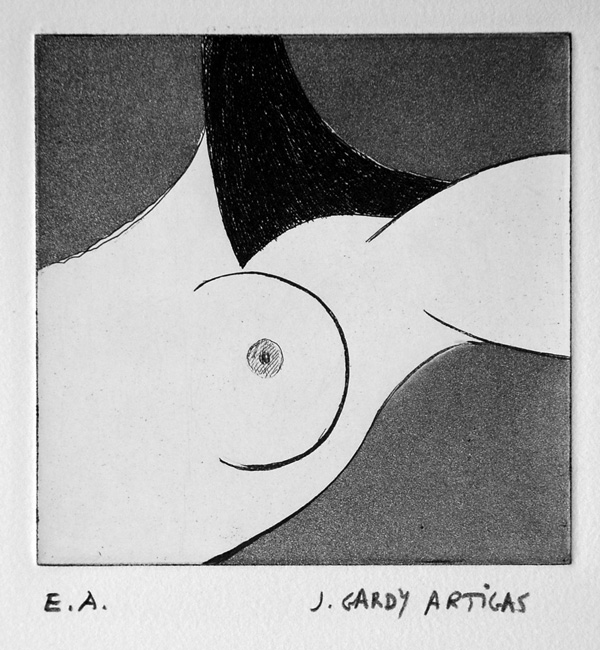 |
|
|
|
|
Petit gravure: Iris, Fleur d'Autriche / Iris, flower of Austria. Original etching, c. 1970. Ours is an E.A. (epreuve d'artiste) impression acquired directly from the artist. Artigas also made a lithograph on this theme (click here), which he seems to have decided was the more appropriate medium for presenting his idea. I have seen nothing to suggest that this piece was ever editioned. Artigas has explained his love of etchings as follows: "If I want a secret image with a magic quality, I turn to etching. The pressure of the damp paper will insure that the intensity of the black, the relief of the features etched on the copper will remain on the paper, giving it a richness and a finesse that forces us to look closely at it, making us wish to hold the etching in our hands, to feel the quality of the paper. The result is a work more secret, more intimate—more precious." Image size: 123x123mm. Price: Please call or email for current pricing information.
|
|
|
|
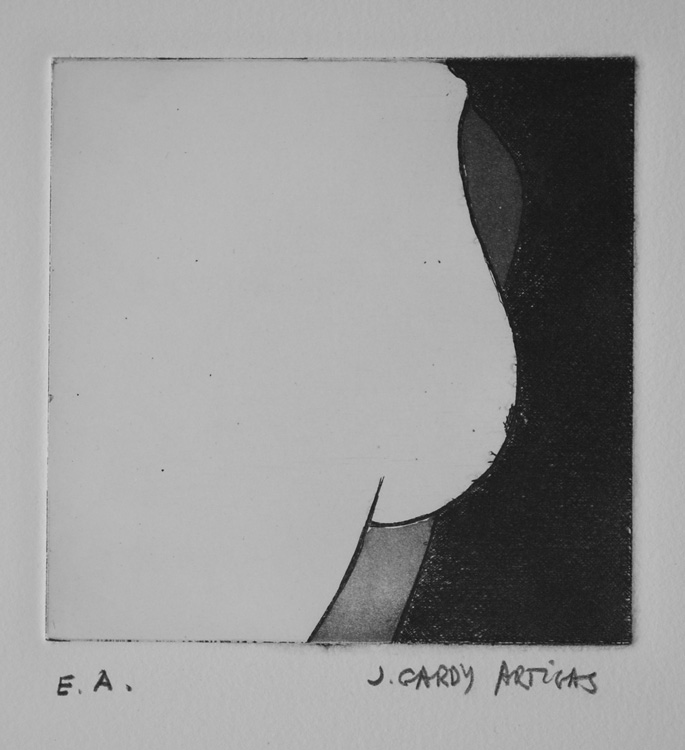 |
|
Petit gravure III. Original etching, c. 1970. Ours is an E.A. (epreuve d'artiste) impression acquired directly from the artist. I have seen nothing to suggest that this piece was ever editioned. Artigas has explained his love of etchings as follows: "If I want a secret image with a magic quality, I turn to etching. The pressure of the damp paper will insure that the intensity of the black, the relief of the features etched on the copper will remain on the paper, giving it a richness and a finesse that forces us to look closely at it, making us wish to hold the etching in our hands, to feel the quality of the paper. The result is a work more secret, more intimate—more precious." The edges of the plate are stillinky and the ink is printing, suggesting that this is oe of the very first impressions pulled after the plate was inked. Image size: 123x123mm. Price: Please call or email for current pricing information.
|
|
|
|
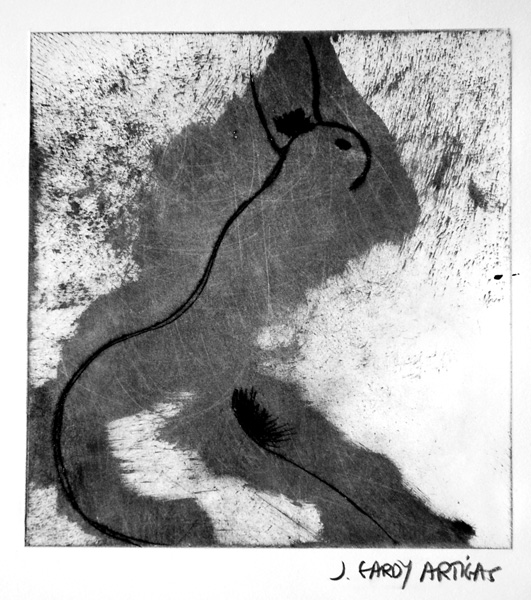 |
|
Dyade chevelue II. Original monotype, c. 1970. Using etching as a base, Artigas here explores the body as a celestial object, a new constellation, inviting us to defamiliarize the familiar so that we can see it new. Ours is a unique work acquired directly from the artist that from the artist that echoes and transforms a lithograph on the same subject of 1970. Artigas has explained his love of etchings as follows: "If I want a secret image with a magic quality, I turn to etching. The pressure of the damp paper will insure that the intensity of the black, the relief of the features etched on the copper will remain on the paper, giving it a richness and a finesse that forces us to look closely at it, making us wish to hold the etching in our hands, to feel the quality of the paper. The result is a work more secret, more intimate—more precious." Image size: 192x195mm. Price: Please call or email for current pricing information.
|
|
|
|
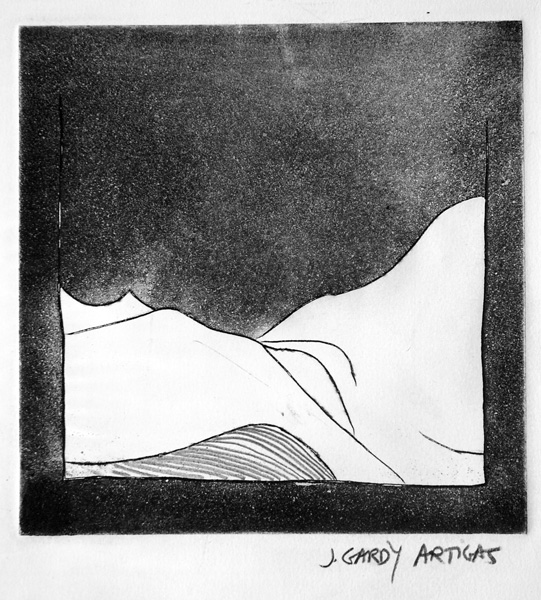 |
|
Paysage Interieur. Original monotype, c. 1970. Using etching as a base, Artigas here explores the body as a desert landscape complete with sand dunes, a new place in which to wander for forty years, lost to our selves and everything else, inviting us to defamiliarize the familiar so that we can see it new. Artigas has explained his love of etchings as follows: "If I want a secret image with a magic quality, I turn to etching. The pressure of the damp paper will insure that the intensity of the black, the relief of the features etched on the copper will remain on the paper, giving it a richness and a finesse that forces us to look closely at it, making us wish to hold the etching in our hands, to feel the quality of the paper. The result is a work more secret, more intimate—more precious." The lines bottom left are all drawn in by hand. Image size: 192x195mm. Price: Please call or email for current pricing information.
|
|
|
|
|
|
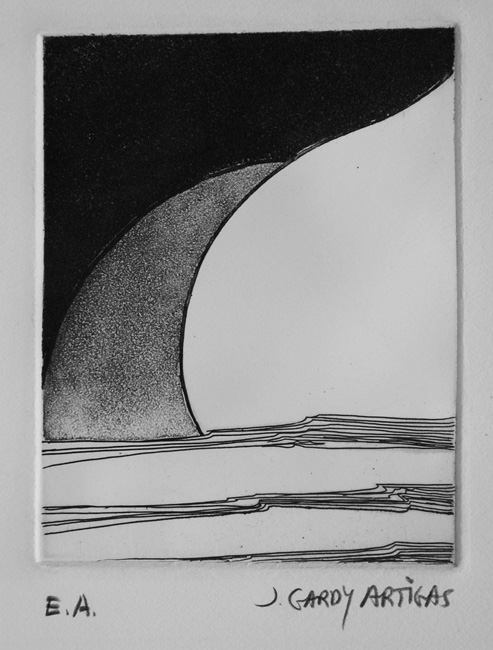 |
|
Petit gravure: Nocturne . Original etching, 1972. Ours is an E.A. (epreuve d'artiste) impression acquired directly from the artist. I have seen nothing to suggest that this piece wasa ever editioned. Artigas has explained his love of etchings as follows: "If I want a secret image with a magic quality, I turn to etching. The pressure of the damp paper will insure that the intensity of the black, the relief of the features etched on the copper will remain on the paper, giving it a richness and a finesse that forces us to look closely at it, making us wish to hold the etching in our hands, to feel the quality of the paper. The result is a work more secret, more intimate—more precious." Image size: 157x126mm on Arches paper. Price: Please call or email for current pricing information.
|
|
|
|
|
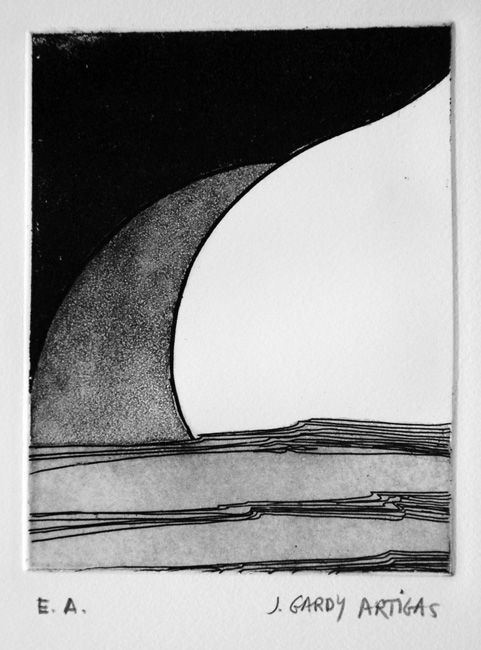 |
|
Petit gravure: Nocturne (II) . Original etching, 1972. Ours is an E.A. (epreuve d'artiste) impression acquired directly from the artist. This is clearly a later version of the etching above in which the lower area has been reworked to hold ink. I have seen nothing to suggest that this piece wasa ever editioned. Artigas has explained his love of etchings as follows: "If I want a secret image with a magic quality, I turn to etching. The pressure of the damp paper will insure that the intensity of the black, the relief of the features etched on the copper will remain on the paper, giving it a richness and a finesse that forces us to look closely at it, making us wish to hold the etching in our hands, to feel the quality of the paper. The result is a work more secret, more intimate—more precious." Image size: 157x126mm on Arches paper. Price: Please call or email for current pricing information.
|
|
|
|
|
|
|
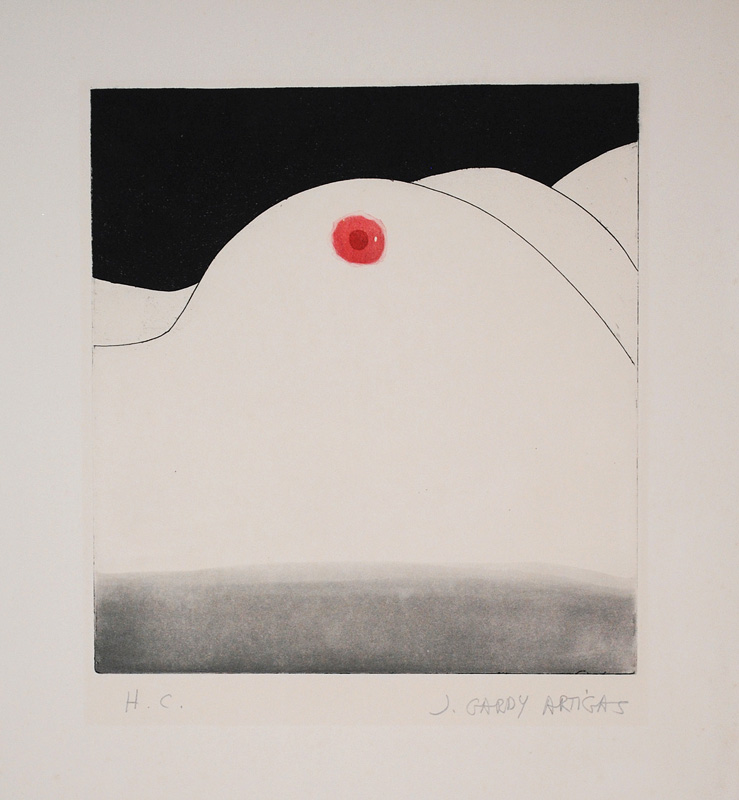 |
|
Gravures Lunaires I. Original color etching, 1972. 30 signed and numbered impressions on Arches published by Maeght Editeur in Paris. Artigas has explained his love of etchings as follows: "If I want a secret image with a magic quality, I turn to etching. The pressure of the damp paper will insure that the intensity of the black, the relief of the features etched on the copper will remain on the paper, giving it a richness and a finesse that forces us to look closely at it, making us wish to hold the etching in our hands, to feel the quality of the paper. The result is a work more secret, more intimate—more precious." Image size: 400x320mm on 748x505mm Arches paper. Price: Please call or email for current pricing information.
|
|
|
|
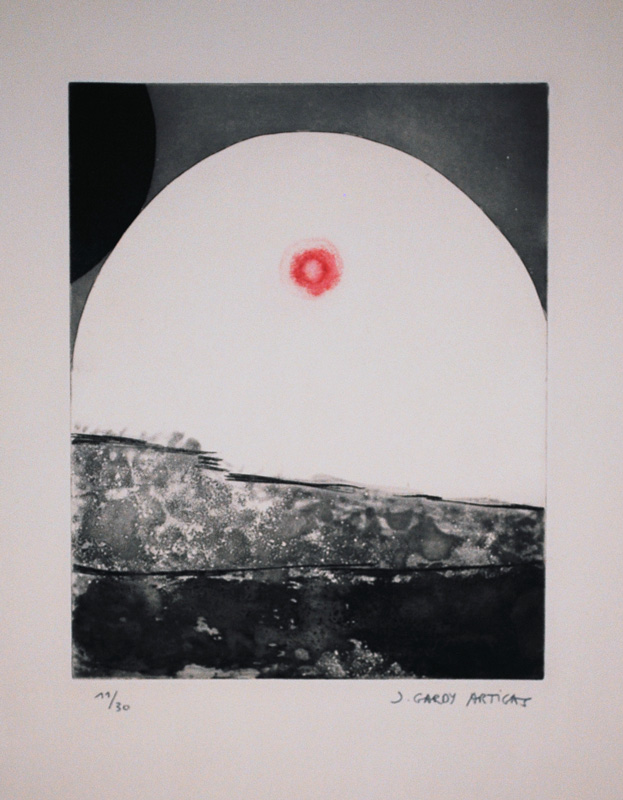 |
|
Gravures Lunaires II. Original color etching, 1972. 30 signed and numbered impressions on Arches published by Maeght Editeur in Paris of which ours is n. 11/30. Artigas has explained his love of etchings as follows: "If I want a secret image with a magic quality, I turn to etching. The pressure of the damp paper will insure that the intensity of the black, the relief of the features etched on the copper will remain on the paper, giving it a richness and a finesse that forces us to look closely at it, making us wish to hold the etching in our hands, to feel the quality of the paper. The result is a work more secret, more intimate—more precious." Image size: 400x320mm on 748x505mm Arches paper. Price: Please call or email for current pricing information.
|
|
|
|
|
|
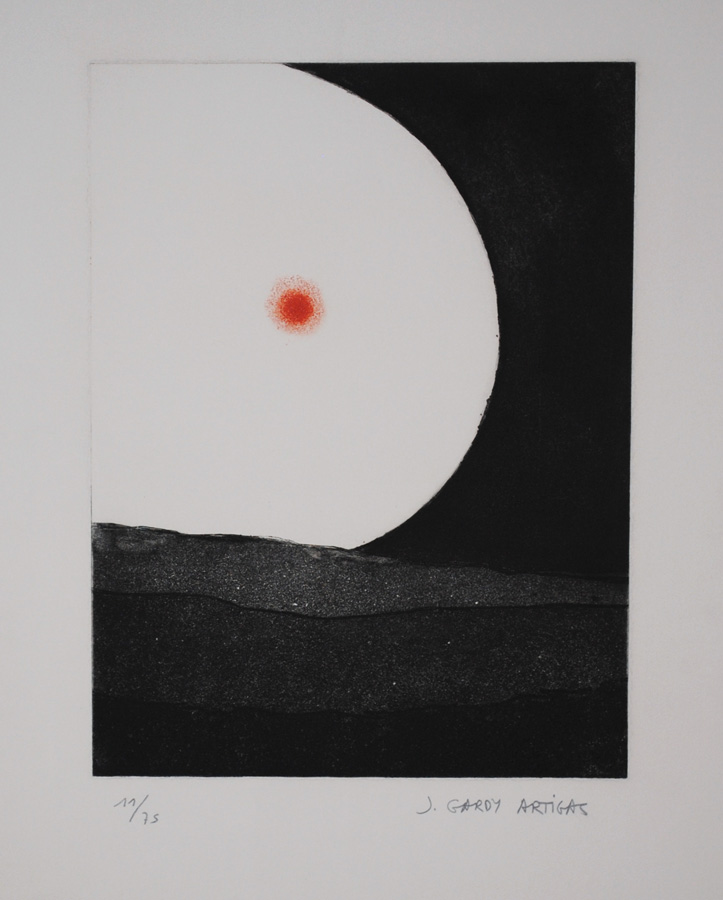 |
|
Gravures Lunaires III. Original color etching, 1972. 75 signed and numbered impressions on Arches published by Maeght Editeur in Paris, of which ours is n. 11/75. Artigas has explained his love of etchings as follows: "If I want a secret image with a magic quality, I turn to etching. The pressure of the damp paper will insure that the intensity of the black, the relief of the features etched on the copper will remain on the paper, giving it a richness and a finesse that forces us to look closely at it, making us wish to hold the etching in our hands, to feel the quality of the paper. The result is a work more secret, more intimate—more precious." Image size: 395x320mm on 657x500mm Arches paper. Price: Please call or email for current pricing information.
|
|
|
|
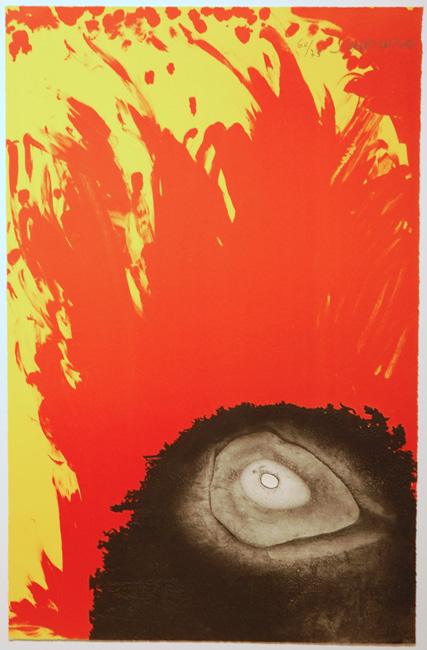 |
|
Incendie / Conflagration. Original color lithograph and etching, 1972. 75 signed and numbered impressions on Arches published by Maeght Editeur in Paris. Artigas has explained his love of etchings as follows: "If I want a secret image with a magic quality, I turn to etching. The pressure of the damp paper will insure that the intensity of the black, the relief of the features etched on the copper will remain on the paper, giving it a richness and a finesse that forces us to look closely at it, making us wish to hold the etching in our hands, to feel the quality of the paper. The result is a work more secret, more intimate—more precious." Image size: 595x385mm. Price: Please call or email for current pricing information.
|
|
|
|
|
|
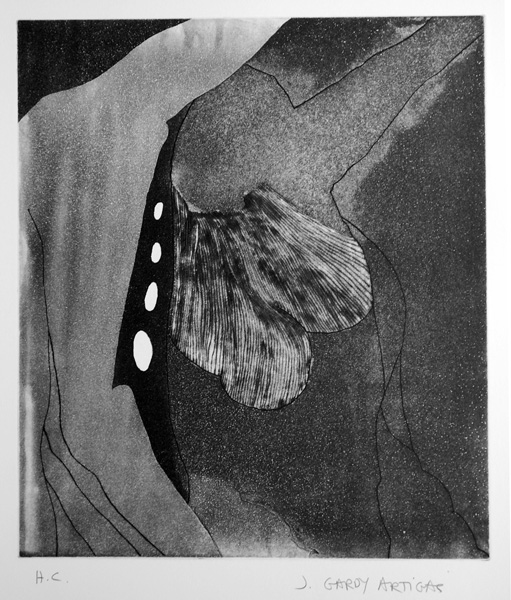 |
|
Le grand discours / Oration. Original etching, 1973. 75 signed and numbered impressions on Rives published by Maeght Editeur in Paris. Ours is an HC impression acquired directly from the artist. Artigas has explained his love of etchings as follows: "If I want a secret image with a magic quality, I turn to etching. The pressure of the damp paper will insure that the intensity of the black, the relief of the features etched on the copper will remain on the paper, giving it a richness and a finesse that forces us to look closely at it, making us wish to hold the etching in our hands, to feel the quality of the paper. The result is a work more secret, more intimate—more precious." Image size: 395x320mm on 760x570mm Arches paper. Price: Please call or email for current pricing information.
|
|
|
|
|
|
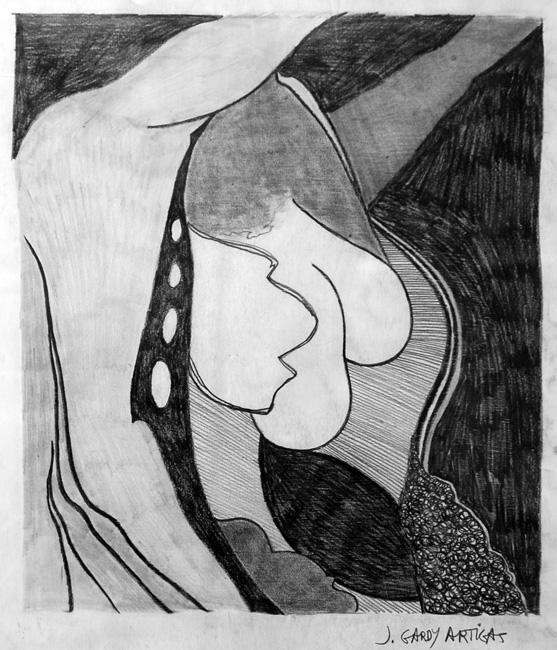 |
|
Le grand discours / Oration. Original drawing, 1973. Artigas' working model for the etching immediately above acquired directly from the artist. Comparison of the two reveals how much improvisation can be involved in the process of making an etching. Image size: 400x345mm. Price: Please call or email for current pricing information.
The etching and drawing are available as a pair at the combination price of Please call or email for current pricing information.
|
|
|
|
|
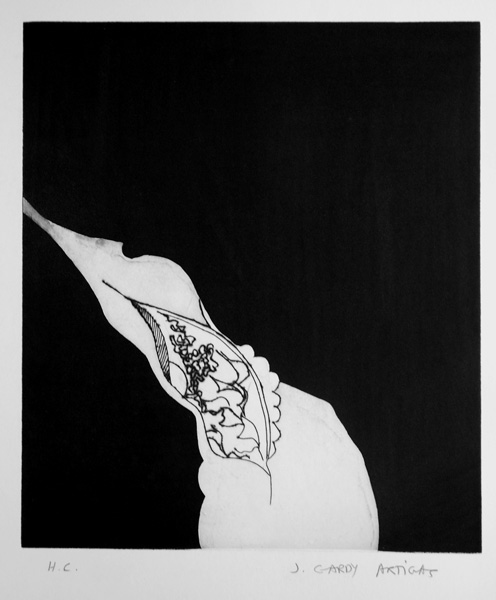 |
|
Le lapin ecorche / Skinned rabbit . Original etching, 1973. 75 signed and numbered impressions on Rives published by Maeght Editeur in Paris. Ours is an HC impression acquired directly from the artist. Artigas has explained his love of etchings as follows: "If I want a secret image with a magic quality, I turn to etching. The pressure of the damp paper will insure that the intensity of the black, the relief of the features etched on the copper will remain on the paper, giving it a richness and a finesse that forces us to look closely at it, making us wish to hold the etching in our hands, to feel the quality of the paper. The result is a work more secret, more intimate—more precious." Image size: 395x345mm on 760x560mm Arches paper. Price: Please call or email for current pricing information.
|
|
|
|
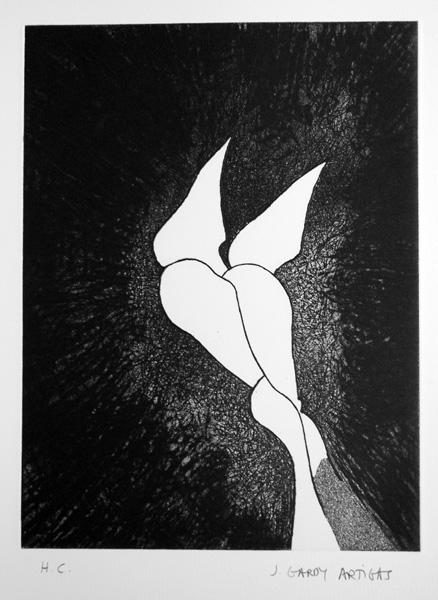 |
|
L'ange de la morte / The angel of death. Original etching, 1975. 75 signed and numbered impressions on Arches published by Maeght Editeur in Paris. Ours is an HC impression acquired directly from the artist. Artigas has explained his love of etchings as follows: "If I want a secret image with a magic quality, I turn to etching. The pressure of the damp paper will insure that the intensity of the black, the relief of the features etched on the copper will remain on the paper, giving it a richness and a finesse that forces us to look closely at it, making us wish to hold the etching in our hands, to feel the quality of the paper. The result is a work more secret, more intimate—more precious." Image size: 393x297mm on 695x500mm Arches paper. Price: Please call or email for current pricing information.
|
|
|
|
|
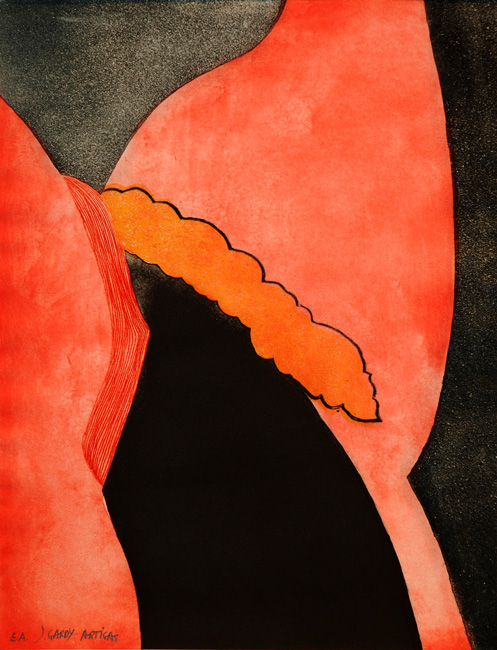 |
|
Gravure en couleurs / Color etching Original color etching, 1975. There was supposed to be an edition of 30 signed and numbered impressions on Arches published by Maeght Editeur in Paris, but I have never seen anything but this HC impression which we acquired directly from the artist. Artigas has explained his love of etchings as follows: "If I want a secret image with a magic quality, I turn to etching. The pressure of the damp paper will insure that the intensity of the black, the relief of the features etched on the copper will remain on the paper, giving it a richness and a finesse that forces us to look closely at it, making us wish to hold the etching in our hands, to feel the quality of the paper. The result is a work more secret, more intimate—more precious." A very rare print (or monoprint?). Image size: 633x490mm on Arches paper. Price: Please call or email for current pricing information.
|
|
|
|
Spaightwood Galleries, Inc.
To purchase, call us at 1-800-809-3343 (1-508-529-2511 in Upton MA & vicinity) or send an email to spaightwood@gmail.com
We accept AmericanExpress, DiscoverCard, MasterCard, and Visa.
We also accept wire transfers and paypal.
For directions and visiting information, please call. We are, of course, always available over the web and by telephone (see above for contact information). Click the following for links to past shows and artists. For a visual tour of the gallery, please click here. For information about Andy Weiner and Sonja Hansard-Weiner, please click here. For a list of special offers currently available, see Specials.
All works are sold with an unconditional guarantee of authenticity (as described in our website listing).
Copyright 2004-2017, Spaightwood Galleries, Inc.
Go back to the top of this page.
Visiting hours: Saturday 10:00 am to 5:00 pm and Sunday noon to 6:00 pm and other times by arrangement.
Please call to confirm your visit. Browsers and guests are welcome.
|
|
|
|
|
|
|
|
|
|
|
|
|
|
|
|
|
|
|
|
|
|
|
|
|
|
|
|
|
|
|
|
|
|














